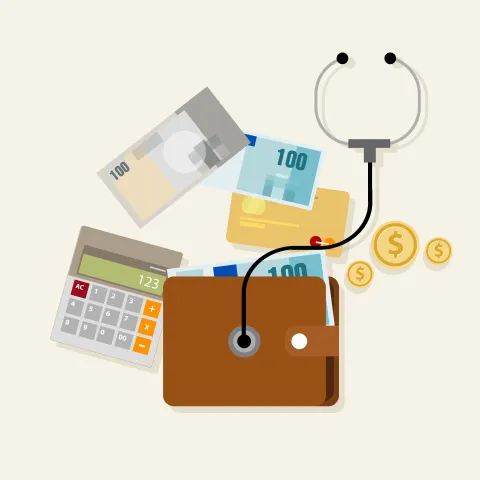
Mid-Year Financial Checkup: 7 Steps to Assess Your Progress
What’s included:
- Steps for a mid-year financial checkup
- Revisit your financial goals
- Evaluate your budget and cash flow
- Measure your savings progress
- Review debt and credit health
- Review retirement and investment accounts
- Plan ahead for taxes
- Update insurance and estate planning
- How often should I do this?
Final thoughts
One of the most empowering habits you can develop is regularly checking in on your financial goals. With the year halfway through, now is an ideal time to reflect on your progress, reassess your priorities, and make any necessary course corrections. Life moves quickly, and your financial strategy should evolve alongside it, whether you're responding to unexpected events or taking advantage of new opportunities.
A mid-year financial checkup isn’t just about reviewing numbers. It’s about gaining clarity, being intentional with your money, and ensuring your next financial decision aligns with your values and goals. Whether you've hit every milestone so far, feel behind, or simply aren’t sure where you stand, this check-in can help you realign your plan for the rest of the year.
How to Conduct a Mid-Year Financial Checkup
You don’t need to be a financial expert to complete a meaningful mid-year review. Follow these seven practical steps to assess your financial health and make smart adjustments for the months ahead.
Step 1: Revisit Your Financial Goals
Start by revisiting the goals you set at the beginning of the year. These could include saving for a vacation, paying down debt, contributing to your children’s education, or preparing for retirement.
Ask yourself:
- Are my goals still relevant?
- Have any life changes (e.g., job change, growing family, health event) affected my priorities?
- Am I on track to meet these goals, can I get on track to meet these goals, or do I need to pivot to something more attainable?
This reflection helps clarify what’s important and ensures your efforts are focused on what you can control. If a goal is no longer a priority, it's okay to redirect your time and money elsewhere.
Step 2: Evaluate Your Budget and Cash Flow
Review your spending habits over the past six months. If you created a budget, compare your actual spending to what you planned.
If you practice reverse budgeting and prioritize saving first, assess how your current savings rate and cash reserves stack up against your original goals.
Key questions to consider:
- Does my spending align with my current goals?
- Are there areas where I consistently overspend or habits that need to be adjusted?
- Did I account for the impact of unexpected expenses?
- Are there upcoming expenses I need to prepare for?
If you’ve drifted off course, use this moment to redirect your focus. That might mean re-prioritizing goals, or making lifestyle adjustments, or increasing savings. Remember, budgeting is not static, it should adapt as your life does.
Step 3: Measure Your Savings Progress
Beyond budgeting, it’s essential to track your progress on savings goals. Start with your emergency fund: has it grown, remained steady, or decreased? While it depends on your unique situation, this fund should generally cover three to six months of living expenses in easily accessible cash or cash equivalents.
Then review your savings across all accounts, including employer-sponsored retirement plans such as 401(k)s, IRAs, Health Savings Accounts (HSAs), brokerage accounts, and 529 plans. Compare your contributions to your income.
Ask:
- Am I saving consistently and sticking to my plan?
- Can I increase (or do I need to adjust) my savings rate?
- Am I managing my spending in a way that supports both short- and long-term goals?
Map out where you want to be six months from now. If needed, consider backup strategies to help you stay on track or make up lost ground.
Step 4: Review Debt and Credit Health
Debt is a common part of peoples’ financial lives, and the way it’s managed can often make or break your financial plan. Make a list of your current debts, including all credit card balances, student loans, auto loans, mortgages, and any other personal or business loans. Review the balances, interest rates, and repayment terms.
Evaluate your repayment strategy:
- Are you prioritizing high-interest or “bad” debt?
- How does your debt impact your monthly cash flow or credit opportunities?
- Would consolidating or refinancing make sense?
- If all your debt is low-interest or “good” debt, should you shift focus from paying down debt to increasing savings instead?
Another important part of your mid-year financial checkup is to request a credit report from TransUnion, Equifax, or Experian. You’re entitled to one free report from each agency annually. Reviewing your report helps ensure accuracy and can identify opportunities to improve your score, such as lowering credit utilization or making timely payments.
Step 5: Review Retirement and Investment Accounts
Whether you're just beginning to save or nearing retirement, regularly reviewing your investment accounts is vital to achieving your long-term goals.
It’s important to check how much you're saving and into which accounts including employer-sponsored plans such as 401(k)s, IRAs, Roth IRAs, HSAs, and brokerage accounts. From there, it is important to ensure your asset allocation matches your risk tolerance, risk capacity, and time horizon.
Ask:
- Is my savings rate aligned with my short- and long-term goals?
- Do my investments and asset allocation accurately reflect my risk profile?
- Am I taking full-advantage of any available employer-match funds?
Adjust your plan as needed to stay on course for retirement and other long-term milestones.
Step 6: Plan Ahead for Taxes
Tax season may seem far away, but mid-year is a great time to be proactive and avoid surprises. Take some time now to estimate your year-to-date income and adjust withholding or estimated payments as needed. Don’t forget to account for changes such as a new job, bonus, inheritance, or relocation that could impact your tax situation. Mid-year is also a good time to explore tax-saving strategies, such as contributing to HSAs or IRAs, donating to charity, or harvesting capital gains or losses.
Ask:
- Has anything changed that could affect my tax situation?
- Do I need to adjust withholding or estimated tax payments?
- Am I optimizing the tax strategies available to me?
Mid-year tax planning can go a long way in reducing stress at year-end. Additionally, making the right tax-planning decisions today can have an enormous impact on your future financial health.
Step 7: Update Insurance and Estate Planning
As your life evolves, so do your risk management and estate planning needs. A mid-year review is a great time to ensure your insurances and estate plan are up to date and remain aligned with your wishes.
Ask:
- What would happen if I am unexpectedly unable to work?
- Have I updated documents to reflect recent life events (marriage, divorce, birth, home purchase)?
- Are there any gaps in my risk management or estate planning?
- Review your insurance coverage: health, life, disability, home, and auto insurance.
- Review your estate documents: wills, trusts, powers of attorney, and healthcare directives.
Staying current on your insurance and estate planning ensures you're protecting both yourself and your loved ones, while maintaining control over your legacy. The Minnesota Credit Union Network has explained that younger demographics, particularly more Gen Zer’s, are interested in buying life insurance but haven’t yet because they “haven’t gotten around to it”. That can be where the problem lies, and where a financial planner can help.
Mid-Year Financial Checkup Checklist
- Reevaluate your financial goals
- Review your actual spending to your budget
- Assess your savings progress and your emergency fund
- Review debt balances and repayment strategies
- Analyze retirement and investment accounts
- Assess tax planning opportunities
- Review and update insurance and estate documents
How Often Should You Conduct a Financial Checkup?
The need for a financial checkup largely depends on your personal situation. However, it is ideal to conduct a full financial checkup at least twice per year. A mid-year review offers a valuable opportunity to assess progress, adapt to life changes, and keep your financial strategy aligned with your goals and values.
Final Thoughts
A mid-year financial checkup is a powerful way to stay intentional, focused, and in control of your financial journey. It offers clarity, reinforces accountability, and helps you proactively plan for the months ahead.
Take time to celebrate your wins, big or small, and identify areas for further progress. If you're unsure where to begin or feel overwhelmed, consider partnering with a financial planner. They can help you evaluate your current position, prioritize next steps, and create a customized plan for the rest of the year and beyond.
The views represented are not meant to be construed as advice. Moreover, no client or prospective client should assume that this content serves as the receipt of, or a substitute for, personalized advice from Affiance Financial, or from any other professional.
Affiance Financial is registered as an investment adviser and only conducts business in states where it is properly registered or is excluded from registration requirements. Registration as an investment adviser is not an endorsement of the firm by securities regulators and does not mean the adviser has achieved a specific level of skill or ability. The firm is not engaged in the practice of law or accounting.
Content should not be viewed as legal or tax advice. You should always consult an attorney or tax professional regarding your specific legal or tax situation. 401(k), IRA, and tax rules are subject to change at any time.
Affiance Financial does not serve as an accountant and does not prepare tax returns.
All investment strategies have the potential for profit or loss. Insurance product guarantees are subject to the claims-paying ability of the issuing company and are not FDIC insured.








